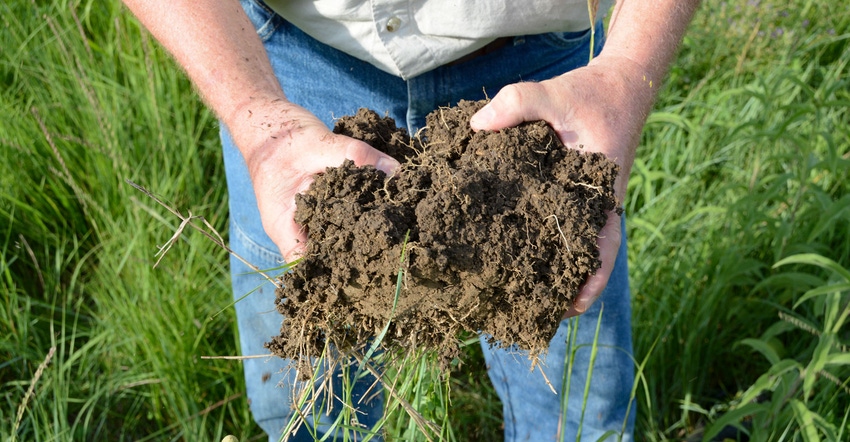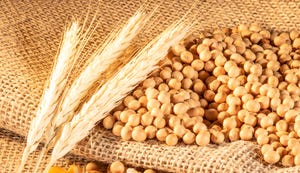
The study of soil health is a relatively new science, as farmers gain an appreciation for the great resource that soil is and recognize its fragility. Anecdotal evidence exists that shows by minimizing or eliminating soil disturbance, farmers can improve the health of soil microbiomes. But what about practices carried over from conventional farming, such as application of pesticides, herbicides, fungicides and fertilizers; do these practices impact soil health? More agronomic scientists are looking at how these practices play into overall soil health.
Among the many sessions during the recent annual meeting of the Soil Health Institute, one afternoon dove into the impacts that agricultural inputs have on soil health.
Glyphosate impact
Jude Maul said in his presentation, “The objectives of our study were to compare factors among modern cropping systems that impact soil communities, plant microbe interactions and plant productivity. And we know that there’s a lot of factors that impact soil microbes including tillage fertility choices, your crop rotation, as well as other choices such as pest control and your crop genotype.”
The study that Maul, a research ecologist with the USDA Agricultural Research Service Sustainable Agricultural Systems Laboratory at Beltsville, Md., spoke of is one conducted at Beltsville, where a number of 30-by-390-foot plots represented five different types of farming systems: a three-year rotation for organic, no-till and chisel-till; an organic rotation that has a six-year cycle that includes perennials including alfalfa; and a two-year rotation. “These types of replicated plots that are in place for a long period of time allow us to ask very specific questions about soils and soil systems,” he said.
One particular question Maul and his team set out to answer was whether or not the use of glyphosate has an impact on the microbial community in the rhizosphere of crop plants. In addition to replication across varied cropping systems and rotations, ARS researchers also replicated the Beltsville research near Stoneville, Miss. “One of the reasons why we use these two locations was to do the same analysis on samples prepared from two very diverse locations, so we could understand the variance in the microbial community that we’re looking at,” Maul said. “So now that we understand just how much soil type plays a role in the variance, we could focus in on just the Beltsville site and use appropriate statistical comparisons to try to understand whether we have treatment effects.”
Spray versus no-spray
The organic systems in the replications have never seen glyphosate, and “we sprayed for two seasons in those plots,” he said, adding that there were no major differences when looking at the fungal community within the rhizosphere fungal community in a spray or no-spray condition and treatment.
Regardless if looking at the Stoneville or the Beltsville site, Maul’s team saw similar distributions in terms of the general population at the order level. At Beltsville, the fungal community was dominated by Hypocreales, Pleosporales and other common organisms at the order level. “If we start drilling down to the genus and species level, what you find is that you have some species of organisms that respond to glyphosate, and some that don’t within the same genus; and the sampling at this resolution, even with 1,000 samples per location — it’s very difficult to differentiate some of these orders from each other, especially within the fungal communities. Much of the functionality of these different classes and groups of fungi are at the subgenus level.”
With some stakeholders interested in the impact glyphosate has on fusarium, he said researchers “took the molecular data that we had and coupled it with old-school, microbiological data and did culturing to look at the occurrence of fusarium on root sections of the sprayed and non-sprayed systems in both the Mississippi and Maryland systems, and we see no significant difference in the fusarium indices.”
Broader picture
Acknowledging that glyphosate is not the only pesticide used in modern farming systems, Terry Gentry related findings from studies looking at the impact that a wide spectrum of herbicides, fungicides and insecticides have on soil health.
Gentry, professor of soil and aquatic microbiology in the Department of Soil and Crop Sciences at Texas A&M University, said from decades-long work largely focusing on soil microorganisms and microbial activity, “We can draw some general conclusions that when we look at things like overall microbial respiration, that at field rates, there doesn’t appear to be much of an effect — at least not a negative effect on soil microbial activity.”
He added that when looking at higher application rates of glyphosate for example, respiration actually starts to increase. “So likely what’s happening there is, the microorganisms are degrading the pesticides,” he said.
Field rate application of glyphosate (less than 10 mg per kg) showed no negative effect on microbial biomass, yet moderate rates (10 to 100 mg per kg) of application showed “a little negative effect,” while a high application rate (more than 100 mg per kg) showed no effect versus the control.
The interaction between pesticides and soil enzymes is a mixed bag, “depending on the pesticides and which enzymes you’re looking at,” he said. “There may be no effect, or they may increase or decrease depending on the pesticide and the enzyme; but where we see effects on microbial activity, generally those are relatively short-lived, and also herbicides typically tend to have smaller effects than we see with fungicides and some of the insecticides.”
When looking at the soil microbial community, Gentry said research presents “strong evidence that pesticide applications, especially repeated applications, induce changes in the soil microbial community.” Adding that most evidence points to a selection of degrader populations that are metabolizing that pesticide, “but using the newer higher throughput sequencing … We’re starting to see some environmental changes.” To illustrate the disruption of bacterial networks that occurs, Gentry cited a study in Argentina looking at soil with no previous history of herbicide exposure or soils that has had herbicides applied for five or 10 years. “What they saw in the soil with no previous history of herbicide exposure was, the application of glyphosate changed the bacterial associations,” he said.
Just as they admitted more work needs to be done in each of their research areas, their current research is far more detailed than can be described here. For more information on their respective studies, contact Maul at [email protected]; or Gentry at [email protected].
About the Author(s)
You May Also Like






